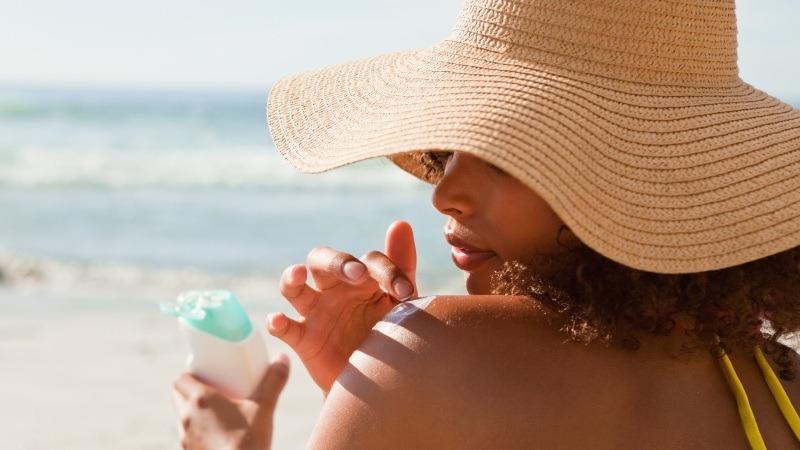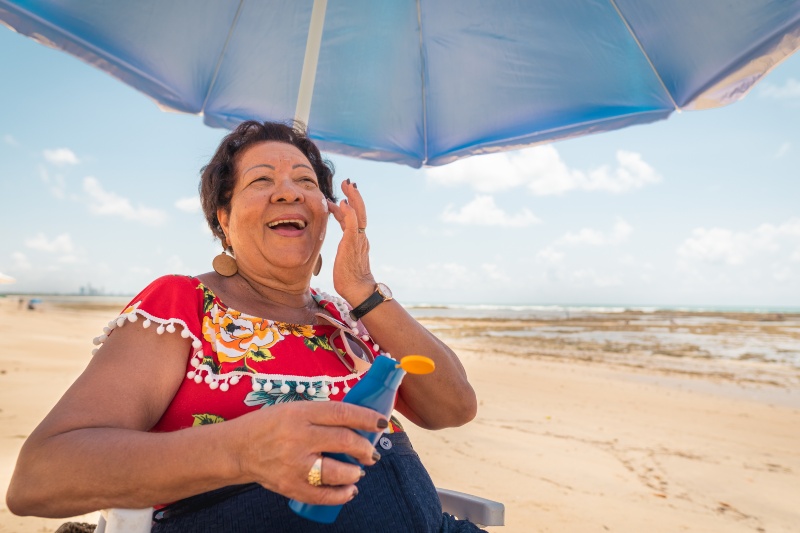- Home
- Mind & body
- Here comes the sunscreen: is a spray or lotion the safest?
At CBHS we help you manage your health challenges. We believe in offering you the services, support and tools you need to live your best life.
Health and Wellness Programs are available to support eligible members towards a healthier lifestyle. Each Health and Wellness Program is subject to its own eligibility criteria.
Contact us for more information and to confirm your eligibility for a program.
Here comes the sunscreen: is a spray or lotion the safest?

Sunscreen is an essential part of an Aussie summer. And most of us know we should be using broad spectrum sunscreen with a sun protection factor (SPF) of at least 30+. But with so many different brands and products to choose from it can be hard to know which one is right for you and your family.
So, which is the best option? Lotion or spray? And does it make any difference if your sunscreen comes from an aerosol, pump spray, roll-on or a tube?
Sprays are not the safest, or the most effective way of applying sunscreen
Children
It might seem easier to spray a squirming child instead of holding them still long enough to rub lotion into their skin, but aerosol sprays don’t always end up where you intend.
If a child turns suddenly, while you’re spraying them, they’re at risk of inhaling the ingredients which can cause lung irritation or even respiratory problems.
Adults
A light mist of spray on your skin won’t be enough to give you adequate sun protection. Did you know that most Australians are applying far less sunscreen than the recommended amount? And, as a result, we’re achieving an SPF of between 50-80% less than the amount that’s specified on the product’s label.
Is the aerosol strong enough?
Aerosol sprays are mixed with propellant, so the actual amount of sunscreen contained in a can is often ‘thinner’ and more diluted than an equivalent lotion or cream. What’s more, according to the consumer watchdog, Choice, only 40-60% of the cans they tested were actual sunscreen. The rest was made up of propellant and chemicals.
Aerosols can be more expensive
We all know that convenience can come at a price. So, while it may be easier and quicker to use a spray-on sunscreen than a lotion, when you factor in the possibility of over-spraying and wind dispersal, an aerosol spray sunscreen can wind up costing you twice as much as a lotion that comes in a tube or pump-action dispenser.
Know the safety issues
Although the risk is small, there have been cases of the propellant in sunscreen catching fire. There’s an obvious risk if you spray near a barbecue or open fire, but you could also be burnt if the product hasn’t had time to dry and you stand too close to a naked flame.
“The Cancer Council has urged Australians to avoid using aerosol sunscreens. Creams, gels and lotions provide greater coverage and longer-lasting protection.”

The burning question: is it time to stop using aerosol sprays?
In 2022, the Cancer Council issued a press release that strongly advised against using aerosols. Creams, lotions and gel-based sunscreens provide easier application as well as greater coverage and longer-lasting protection against harmful UV rays.
Dr Rick Tinker, Director of Assessment and Advice for the Australian Radiation Protection and Nuclear Safety Agency (ARPANSA), elaborates,
“If applied correctly and in combination with other forms of sun protection, sunscreen lotions can lower our melanoma risk, the deadliest form of skin cancer.
As further confirmation of their strong stance against aerosol sunscreens, the Cancer Council withdrew their own brand from the market in 2017.
Don’t scrimp on your sunscreen!
Less is not more when it comes to how much sunscreen you should use. So, if you want to benefit from the full protection promised on the label, you should apply generous amounts.
The general recommendation is around 45ml per adult – that’s around nine ‘teaspoons’ of sunscreen –
- one for your face, head and neck
- two teaspoons for your torso
- one for each arm and forearm
- and two teaspoons for each of your legs.
As well as applying your sunscreen, you should also make sure that you add extra protection where possible like wearing long-sleeved clothing and seeking out the shade of trees or a beach tent. And, remember to re-apply your sunscreen regularly. According to the Cancer Council guidelines, you should be re-applying your sunscreen after two hours if you’re spending time outside – sunscreen can be lost or wiped away through perspiration and swimming.

Whether you use a spray or lotion, they still take time to ‘work’
If you were to look at your skin under a microscope, you’d see that it’s made up of ‘peaks and troughs’. So when you apply sunscreen, it generally takes up to 20 minutes for the UV-blocking ingredients to flow into these troughs and properly bind to your skin. That’s why you should apply sunscreen at least 20 minutes before exposure to the sun whether you’re using a lotion or spray.
You’ll also notice that a lot of sunscreen brands recommend that you re-apply every two hours. This is because after that ‘first coat’ has dried, your skin will benefit from more reliable coverage with the second application of sunscreen. You’re likely to cover the areas of skin you missed the first time around.
“Aussies are only achieving an SPF of between 50-80% less than the amount on the sunscreen label because we’re not using enough!”

Let the sun shine in. Use a cream-based sunscreen for greater protection
Australian summers – and our beautiful beaches – are world-famous. But the harsh Aussie sun is equally well known for its harmful effects. So every sun-lover must slip on protective clothes, slap on a hat, seek shade, slide on those sunnies
– and most important of all – slop on that SPF30 water-resistant sunscreen.
As well as reducing the ageing effects of the sun, sunscreen can also minimise our risk of developing skin cancer and
sunburn. And while aerosol sunscreens might appear to be a quick and easy way to ‘cover up’ – they don’t offer the same level of protection and coverage – or value for money – as creams and lotions, either in tubes
or pump applicators. Using them is also strongly discouraged by the Cancer Council.
So, when it comes to choosing the right sunscreen for you – and your family - it’s better to be safe than sunburnt. Choose a cream-based formula
over an aerosol for maximum UV-ray protection – and enjoy the great Aussie outdoors!
All information contained in this article is intended for general information purposes only. The information provided should not be relied upon as medical advice and does not supersede or replace a consultation with a suitably qualified healthcare professional.
Sources:
https://www.tga.gov.au/behind-news/be-sun-smart-wear-sunscreen
https://www.cancer.org.au/cancer-information/causes-and-prevention/sun-safety/about-sunscreen
https://www.consumerreports.org/sunscreens/right-way-to-use-spray-sunscreen/
Health and wellbeing
programs & support
You Belong to More with CBHS Hospital cover:
- Greater choice over your health options including who treats you
- Get care at home with Hospital Substitute Treatment program
- Free health and wellbeing programs to support your health challenges
Live your healthiest, happiest life with CBHS Extras cover:
- Benefits for proactive health checks e.g. bone density tests, eye screenings
- Keep up your care with telehealth and digital options
- Save on dental and optical with CBHS Choice Network providers
